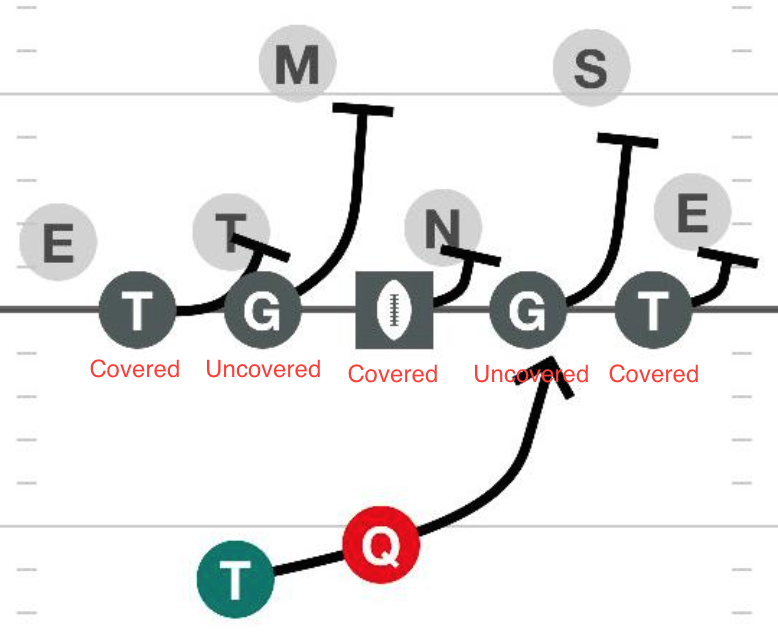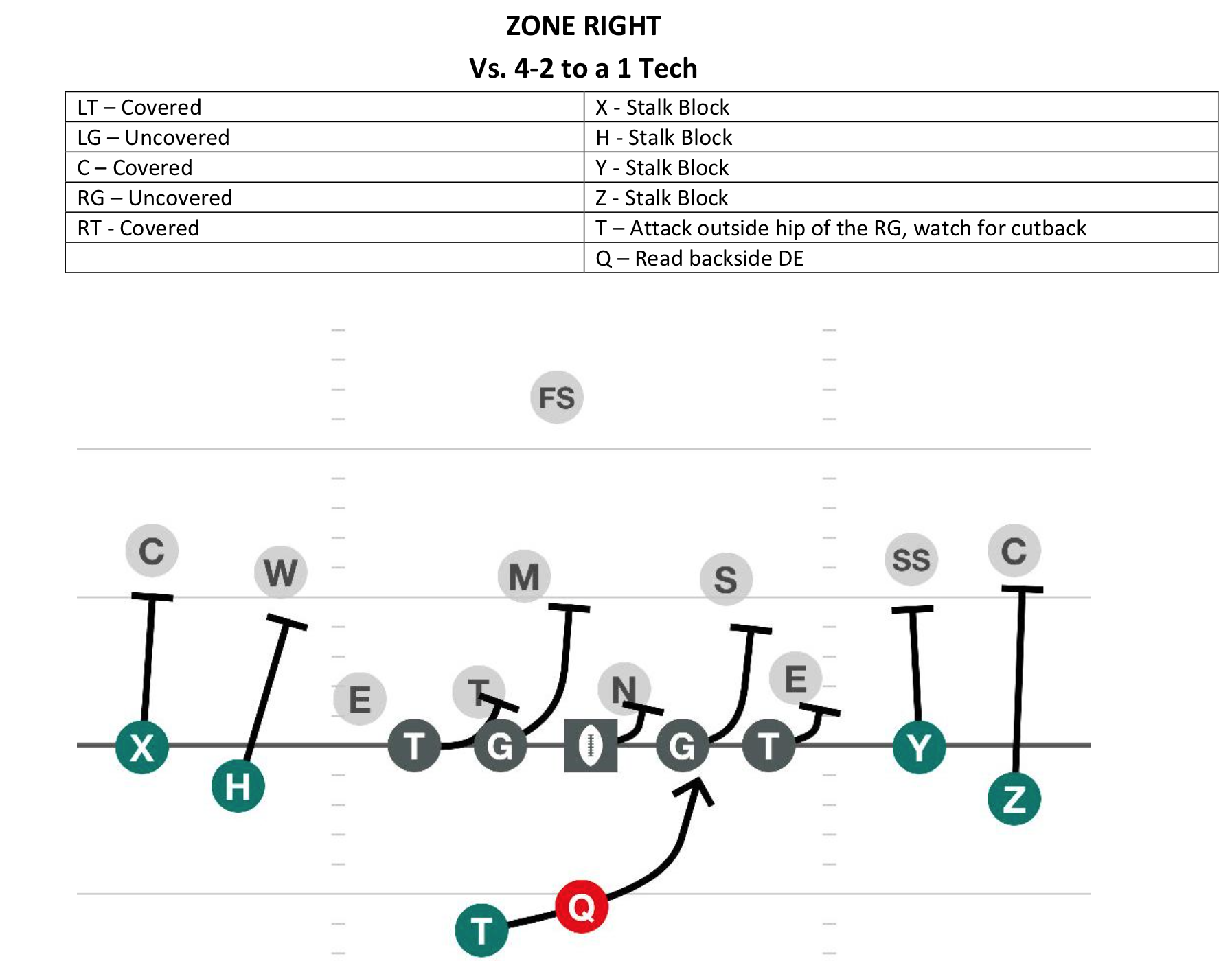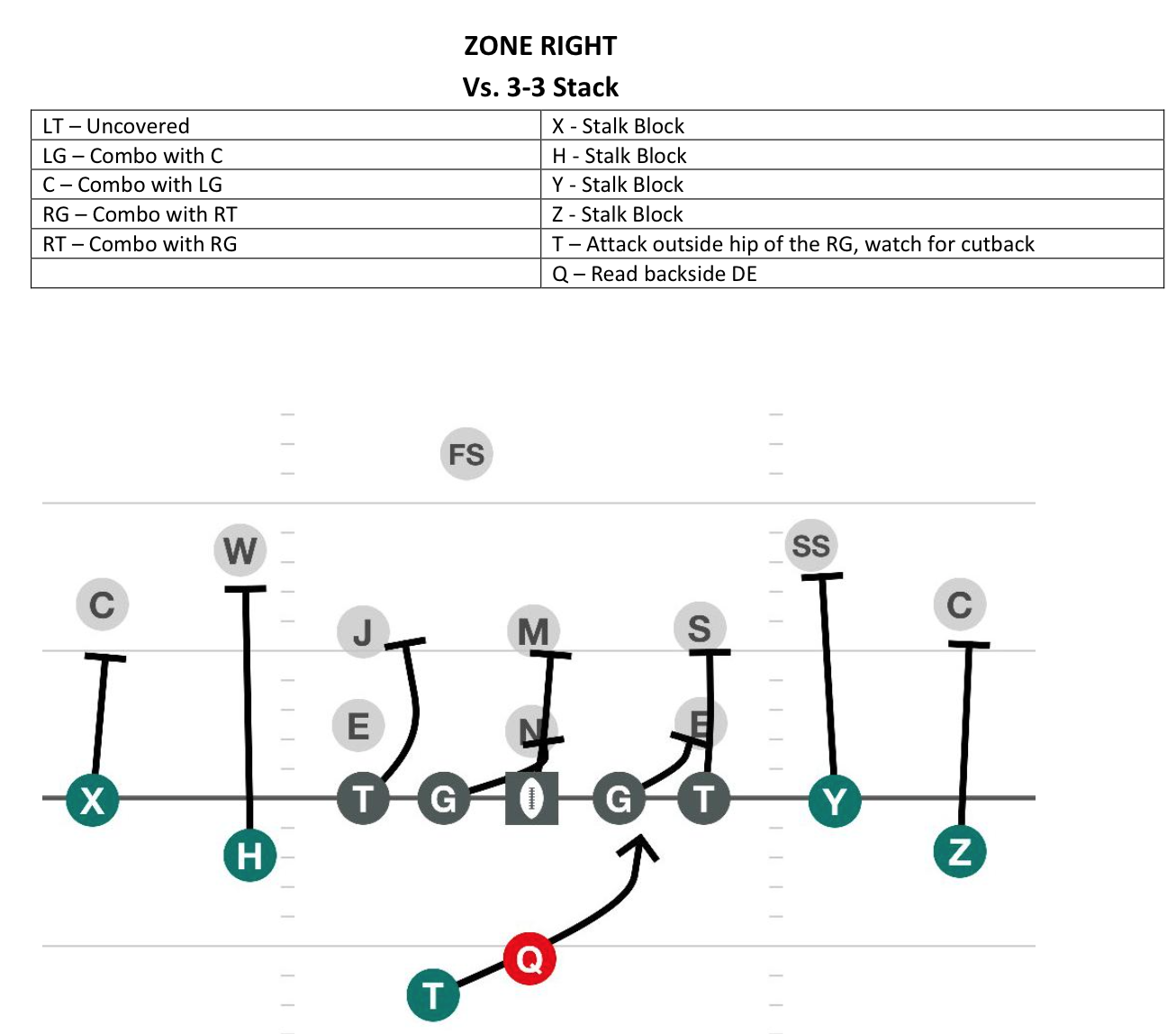Inside Zone
Hey guys, thanks again for reading. I really appreciate it. Today we are going to begin a series of posts about the run game by exploring what I think is the most versatile run play in the entire offense…Inside Zone. The goal of this post is two-fold. First, I want to talk about the reasons that Inside Zone should be a part of your offense. Second, I want to give a few tips and pointers on how to teach it effectively.
But before we do that, I have to remind you of two things. First, if you haven’t downloaded the Win With The Pass Spread Running Game Playbook, do it now. It’s free! Second, if you are interested in perfecting the Spread Running Game, you have to check out the Spread Running Game Academy. We have over 7 hours of video content dedicated to the Spread Running Game. It really is the ultimate clinic. Click Here to check it out.
We can all agree that there are a million ways to run the ball. Eery running play looks good on the chalkboard. But, if you are not running inside zone, I have to ask why?
I don’t say that with any judgment or any haughtiness. I am legitimately asking you why?
Maybe you don’t think you have the guys up front. Maybe you think your back can’t see the cut back lane. Maybe you think zone is a “soft” play that encourages linemen to stand up and lose leverage. Maybe you think the play is too hard to teach and takes too much work to install.
Those are all valid concerns and I know that none of us build our playbook or our game scripts without a ton of thought. But, I think that Zone actually has built in answers to all of those concerns if we coach it and communicate it the right way.
So, let’s look at a few of these concerns
1) I don’t have the size up front to block Inside Zone.
That’s ok. You don’t have to be big to zone block. First of all, the scheme that I teach is built on the concept of double teams. 2 small guys can generate movement on 1 big guy. Second, if they are in a 1 on 1 situation we teach our linemen to reach block on Zone. The reach is all about speed and quickness. It’s all about getting off the ball before your opponent and working your head and hips to the outside number. Smaller guys can get this done.
2) My back can’t see the cutback lane.
Some backs are blessed with vision and lateral quickness. If you have one of those guys, he was made for this play. But, you can also teach the most robotic back in America to anticipate the cutback lane if you know what to look for and how to communicate.
I had a kid a few years back named Ryan Montgomery. He was a track kid, strong and pretty fast, but he had no shake whatsoever and pretty terrible vision. He couldn’t jump cut or run a 45 degree cone drill without slowing down every step. But, he was strong with the ball and had good top end speed. He also worked really hard and he was coachable. Because we knew that he would not see the hole or hit the cutback lane, we had two options. Ether we scrapped Zone, or we found a way to teach him to run it. We decided on the latter, and taught Ryan to keep the ball playside unless there was a backside 1-technique. Most of the time the cutback lane on Zone happens when a guard can’t cutoff a backside A Gap player. This isn’s always the case and sometimes Ryan would run right into a defender because he listened to us. But, by making that little adjustment, we were able to take a running back with below average vision and teach him to hit the cutback lane.
3) Zone is a “Soft” play.
This is pure myth. A lot of coaches think Zone teaches running backs to dance and linemen to stand up, but Zone is like anything else in football. It’s only soft if you allow it to be. I think Zone can be one of the most physical plays in the offense if you teach it that way. Think about it. You get at least 1 double team up front where 2 guys have the chance to drive block a down defender to linebacker level. That’s as physical as it gets. Your back gets to make 1 cut and run downhill. He’s not supposed to dance or wait. Make your cut and get vertical. Zone is a downhill, hard-nosed play
4) Zone takes a lot of time to install.
I’m not going to dispute this. It takes a lot of reps to get good at Inside Zone. But, I would argue that while there is a lot of work that goes into it on the front end, the back end versatility actually saves you time. First, the rules don’t change vs. any front (although you can teach it a bit differently if you are playing a lot of 3-3 stacks). While Lead and Iso and Power and Dart all have to be retaught and tweaked depending on what the defense does, Zone’s rules stay constant. Moreover, Zone is sometimes the only play that works against moving and stunting fronts. It’s really hard to prep for every look, every blitz, and every twist that you might see against certain fronts. But, Zone solves a lot of the issues by giving very simple and consistent rules.
Second, by installing Zone you have already installed 90% of Stretch. The rules are the same for both of these plays. The angles change a bit, because of the path of the running back so the linemen need to know that they may be on a full sprint to reach a linebacker. But, the hardest question, “Who do I block?” has already been answered.
Third, Zone is the perfect blocking scheme for play action, boots, run/pass option plays, and quick screens. So, every time you install one of these, the blocking scheme takes no work. It also works for other plays in the run game. For example, you can run Speed Option by telling all your linemen to block Zone except the playside tackle who sifts or arcs to the backer. You can run lead by blocking Zone with everyone but just telling your center and guard to stay on the double team forever so a TE in motion or a FB can iso on the middle backer.
Zone is the best play to run if you want to play really fast. If your goal is to run the play before the defense can substitute or even before they can get set, zone is the perfect call. It’s tough to run Trap or Power, because sometimes defenders are out of position and will luck into a tackle simply because they don’t get blocked. Zone solves this issue because it has simple rules that account for misaligned defenders. No matter where a defender aligns he will be accounted for.
HOW TO TEACH ZONE
Ok, now comes the technical part. How do we teach Inside Zone?
I teach the combo block, and I teach Covered and Uncovered Principles. So, every time a linemen comes up to the ball he will say Covered, Uncovered, or Combo. Each of these calls will dictate how he blocks the play.
To be “Covered” means that there is a defender between your “head up” and the nearest playside lineman’s “head up.” To be “Uncovered” means that there is no defender in that area. The nearest defender is either inside of you or outside of the guy next to you.
So, if you are the Left Guard and we are running Zone Right, you are covered if there is a defender head up or in the A Gap. You are Uncovered if there is a defender in the B gap or head up on the center.
If you are Covered, your job is to execute a reach block on the defender that is covering you. This means that you will take reach step with your playside foot, and step with your backside foot toward the outside armpit of that defender. You have two goals. 1) Get your head outside of that defender 2) Try to generate vertical movement or at least to not give up penetration. We can win with 5 stalemates as long as we get our heads outside the defenders.
If you are Uncovered, your job is a bit more complicated. Your first job is to double team with the nearest playside lineman to help him generate vertical movement. You can stay on this double team until your 2nd level defender becomes a threat. If the nearest playside lineman’s defender is lined up way outside, and you can’t get to him, you can give a hand to the backside lineman while you eyeball the 2nd level. Then, you will come off of your double team and block the 2nd level defender. This will most likely be a linebacker, but could be a safety depending on the front.
Or, if you come up to the line and you are uncovered, but the guy next to you has a head up defender with a stacked backer, you can make a combo call. This means that both of you are going to push the down linemen to the level of the backer and the direction that the backer flows will dictate which lineman comes off on him.
For example, if you are playing Right Guard, we are running Zone Right and they have a C gap defender and an A gap defender. You are uncovered. But, you won’t get to the C gap player in time to give your tackle any help. So, you might as well help the Center generate vertical movement on the A Gap player while you keep your eyes on the 2nd level.
Here is an example of Covered and Uncovered calls on Zone Right.
Notice, once a lineman identifies himself as covered, he is responsible for the down linemen. He will not come off on a backer. This is different than a combo call, where either linemen will come off, depending on the flow or stunt of the backer. In this case, instead of saying Covered or Uncovered, the linemen will simply say “Combo.”
This is a likely scenario in a 3-3 or a 50 with a true nose.
Here are a few examples of what Zone looks like against different fronts.
OTHER TIPS
Now that you have the play blocked, there are a couple things you need to teach your QB and RB in order to be effective running Zone.
First, you have to trust your QB to read the backside. Otherwise, the contain defender can close down the line, eliminate the cutback lane, and kill the play. If you did a good job selecting your QB, he should at least be a serviceable runner. The threat has to be real.
I think a lot of coaches make this read too complicated. They talk about DE’s turning their shoulders or crossing over with their outside foot, or they talk about not letting the ball go past the front hip of the back. That’s too much and it’s not applicable to all QB’s. Some are quicker than others, some are slower than others. Here is a simple rule: I tell my QB’s that they should err on the side of giving the ball. When in doubt, give the zone and let your RB work. But, if you feel like you can get the edge pull the ball. That’s it. It’s simple. If you can get the edge, take it.
Remember, this is the kid you trust to run your passing game where he has to make 3 or 4 reads every play. You have to trust him with this simple read.
For the RB, his alignment should be 1×1 with the QB, 1 yard deep and 1 yard outside. This will allow a little more time for the cutback lane to develop and give him a downhill path. His first step is a lateral step with his playside foot. This should mirror the first step of the linemen. Then he aims at the outside hip of the playside guard. His rule is to press the hole and read the guard’s block. If the guard’s head is outside of his defender, the back will keep the play playside. If the defender beats the guard across his face, he will cut it back. Once he makes this one decision, get downhill and run hard.
The final tip is simple. Reps, reps, reps. If you have downloaded my installation guide you know that sometimes we spend the entire practice running only Zone. You have to rep it over and over and over in order to really get proficient at it.




